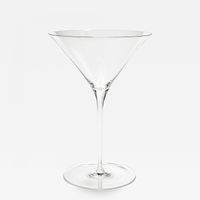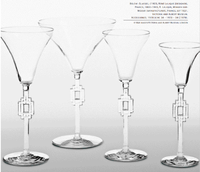Martini Glass: Difference between revisions
No edit summary |
No edit summary |
||
| Line 1: | Line 1: | ||
[[File:Martini-Glass-by-Oswald-Haerdtl.jpg|200px|thumb|right|Oswald Haerdtl | [[File:Martini-Glass-by-Oswald-Haerdtl.jpg|200px|thumb|right|Oswald Haerdtl "Ambassador" Glass from 1925]][[File:Rene_Lalique_1925_Paris_Exposition.png|200px|thumb|right|René Lalique "Hagueneau" Glass from 1925]] | ||
The term “Martini Glass” has come to be a reference to a relatively specific style of “Cocktail Glass”. The Martini glass is characterized as being a stemmed cocktail glass, with a bowl that has very straight sides at almost a 45-degree angle. | |||
A Martini Glass is not just for Martinis, just as what is commonly referred to as an Old Fashioned Glass is not just for Old Fashioneds. These two glasses have simply taken on the name of the most iconic drink that is served in them. | |||
The basic form of the Martini Glass is extremely simple and can be found reflected in various drinkware throughout the centuries. It is however not a terribly commonly used design, partially because the straight 45-degree angle of the sides doesn’t make it very practical for holding liquids. it makes far more sense to have more vertical sides on a glass instead. | |||
Exactly when the Martini Glass first came onto the scene can be difficult to narrow down. On one hand you could try to point to the various appearances of a glass in this general shape across the centuries and perhaps try to identify one of these as the being the first Martini Glass. On the opposite end of the spectrum, you could try to find when a glassware company first sold a glass that they were listing as a “Martini Glass”. Neither of these are probably the right event to claim as the origin of the Martini glass. | |||
From time to time, you may encounter comments along the lines of “The modern Martini glass was first had its debut at the 1925 Paris Exposition”, but with little in the way of additional details.<ref>[https://www.irishtimes.com/life-and-style/homes-and-property/design-moment-martini-glass-1925-1.4094434 "Design Moment: Martini glass, 1925"] The Irish Times</ref><ref>[https://www.economist.com/1843/2018/10/10/why-the-martini-glass-is-a-classic-despite-its-shape "Why the martini glass is a classic, despite its shape"] The Economist</ref><ref>[https://www.absolutdrinks.com/en/learn/the-iconic-cocktail-glass/ "The Iconic Cocktail Glass"] Absolut</ref><ref>[https://www.vam.ac.uk/blog/design-and-society/pandemic-objects-cocktail-glass "Pandemic Objects: The Cocktail Glass"] Victoria and Albert Museum]</ref><ref>[https://sipmagazine.com/origin-stories-behind-4-classic-drink-glasses/ "The Stories Behind 4 Classic Drink Glasses"] Sip Magazine</ref> With some sleuthing, there have so far been two possible glasses we’ve found which were on display here that could fit the bill. Both of these glasses were first manufactured in 1924, and they were also both presented as a new take on the common Champagne coupe, which was also often used for cocktails. | |||
One is the Hagueneau champagne glass (Model #5024), designed by René Lalique and manufactured by the Lalique glassworks in Wingen-Sur-Moder. It was fairly stylized with the design embellishments the exposition was focused on and would become known as “Art Deco”. The sides of the glass weren’t quite the simple straight lines we typically attribute to the Martini glass today.<ref>[https://www.theage.com.au/multimedia/art_deco/pdf/Gill03.pdf Dreams Made Real] (René Lalique Martini glass from 1925 Paris Exposition)</ref><ref>[https://www.metmuseum.org/art/collection/search/481752 Met Museum Hageneau Collection]</ref><ref>[http://collections.vam.ac.uk/item/O249605/hagueneau-madeira-glass-lalique-rene-jules/ V&A Collections]</ref><ref>[https://rlalique.com/rene-lalique-hagueneau-glass René Lalique Enthusiasts]</ref> | |||
The second glass was from the Ambassador line (model # TS240GL) produced by J. & L. Lobmeyr in collaboration with famed architect Oswald Haerdtl, which anybody would immediately recognize as an elegant, but standardly classic, Martini glass. This glass, which is still produced today, is exactly what comes to mind when you think of a “Martini Glass”.<ref>[https://www.lobmeyr.at/produkte/1905/361 J. & L. Lobmeyr Ambassador glassware collection #240]</ref> | |||
While both of these glasses could be seen as heralding the entrance of the Martini Glass, it is the Ambassador that could very easily “be” the original Martini Glass. This isn’t to say that it was the first glass of this form in which a Martini was served, and since (to the best of our knowledge) was never directly sold “as” a Martini Glass, there is still some room for further discovery. But suffice it to say, we are currently willing to say that the Ambassador, in 1925, at the Paris Exposition, is the birth of the Martini Glass. Any further details or updates will be added here as they are encountered. | |||
==References== | ==References== | ||
Revision as of 17:33, 27 January 2021
The term “Martini Glass” has come to be a reference to a relatively specific style of “Cocktail Glass”. The Martini glass is characterized as being a stemmed cocktail glass, with a bowl that has very straight sides at almost a 45-degree angle.
A Martini Glass is not just for Martinis, just as what is commonly referred to as an Old Fashioned Glass is not just for Old Fashioneds. These two glasses have simply taken on the name of the most iconic drink that is served in them.
The basic form of the Martini Glass is extremely simple and can be found reflected in various drinkware throughout the centuries. It is however not a terribly commonly used design, partially because the straight 45-degree angle of the sides doesn’t make it very practical for holding liquids. it makes far more sense to have more vertical sides on a glass instead.
Exactly when the Martini Glass first came onto the scene can be difficult to narrow down. On one hand you could try to point to the various appearances of a glass in this general shape across the centuries and perhaps try to identify one of these as the being the first Martini Glass. On the opposite end of the spectrum, you could try to find when a glassware company first sold a glass that they were listing as a “Martini Glass”. Neither of these are probably the right event to claim as the origin of the Martini glass.
From time to time, you may encounter comments along the lines of “The modern Martini glass was first had its debut at the 1925 Paris Exposition”, but with little in the way of additional details.[1][2][3][4][5] With some sleuthing, there have so far been two possible glasses we’ve found which were on display here that could fit the bill. Both of these glasses were first manufactured in 1924, and they were also both presented as a new take on the common Champagne coupe, which was also often used for cocktails.
One is the Hagueneau champagne glass (Model #5024), designed by René Lalique and manufactured by the Lalique glassworks in Wingen-Sur-Moder. It was fairly stylized with the design embellishments the exposition was focused on and would become known as “Art Deco”. The sides of the glass weren’t quite the simple straight lines we typically attribute to the Martini glass today.[6][7][8][9]
The second glass was from the Ambassador line (model # TS240GL) produced by J. & L. Lobmeyr in collaboration with famed architect Oswald Haerdtl, which anybody would immediately recognize as an elegant, but standardly classic, Martini glass. This glass, which is still produced today, is exactly what comes to mind when you think of a “Martini Glass”.[10]
While both of these glasses could be seen as heralding the entrance of the Martini Glass, it is the Ambassador that could very easily “be” the original Martini Glass. This isn’t to say that it was the first glass of this form in which a Martini was served, and since (to the best of our knowledge) was never directly sold “as” a Martini Glass, there is still some room for further discovery. But suffice it to say, we are currently willing to say that the Ambassador, in 1925, at the Paris Exposition, is the birth of the Martini Glass. Any further details or updates will be added here as they are encountered.
References
- ↑ "Design Moment: Martini glass, 1925" The Irish Times
- ↑ "Why the martini glass is a classic, despite its shape" The Economist
- ↑ "The Iconic Cocktail Glass" Absolut
- ↑ "Pandemic Objects: The Cocktail Glass" Victoria and Albert Museum]
- ↑ "The Stories Behind 4 Classic Drink Glasses" Sip Magazine
- ↑ Dreams Made Real (René Lalique Martini glass from 1925 Paris Exposition)
- ↑ Met Museum Hageneau Collection
- ↑ V&A Collections
- ↑ René Lalique Enthusiasts
- ↑ J. & L. Lobmeyr Ambassador glassware collection #240
External Links
- J. & L. Lobmeyr Ambassador glassware collection #240
- "Ambassador" Oswald Haerdtl Martini Glass from 1925 (Oswald Haerdtl Martini glass from 1925 Paris Exposition)
- "Ambassador" Set No. 240 Martini Glass by Oswald Haerdtl (Adeeni Design Group)
- Dreams Made Real (René Lalique Martini glass from 1925 Paris Exposition)
- History of the Martini Glass Jared Brown, Sipsmith

